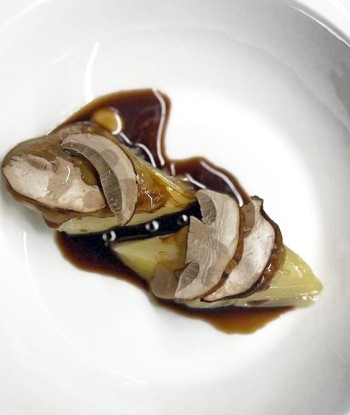A fresh pasta dish that follows tradition prepared by the chef of La Locanda del Cardinale in Assisi
First broth:
- 1 capon
- 2 celery ribs
- 4 carrots
- 4 golden onions
- 20 black peppercorns
- 2 bay leaves
- 1 sprig of rosemary
- 15 l cold water
Procedure
Insert all the ingredients cold and cook over very low heat, maintaining a gentle simmer for at least 12 hours, preventing the liquid from boiling excessively. After the 12 hours have elapsed, let it rest for at least 6 hours. Next, strain the broth using a fine-mesh strainer (chinois), scooping it gently with a ladle to avoid dislodging impurities deposited at the bottom of the pot.
Second broth
- 1 capon
- 1 celery stalk
- 2 carrots
- 2 onions
- the broth made the day before filtered
Procedure
Reinsert all the cold ingredients, including the first prepared broth, and proceed with cooking following the exact same method used for the first broth. When finished, strain again and adjust fine salt if necessary.
Egg pasta
- 500g of type “0” flour
- 166g of semolina
- 290g whole eggs
- 90g of yolks
Procedure
Place all ingredients in a planetary mixer and knead the dough with the dough hook for about 10 minutes. If the dough is too dry, add an extra egg. When the dough becomes smooth, remove it from the planetary mixer and wrap it tightly with clingfilm. Allow to rest in the refrigerator for 12 hours.
For the filling
- 166g beef
- 166g pork meat
- 166g of chicken meat
- 66g celery
- 66g onion
- 66g Parmigiano Reggiano cheese
- 1 whole egg
- nutmeg
- lemon zest
- white wine
- salt and pepper
Procedure
Brown the meat at a moderate temperature in a skillet with a drizzle of extra-virgin olive oil, taking care not to overcook it-all three types of meat should remain medium-cooked. Once browned, remove the meat from the pan and put the coarsely chopped vegetables in its place. Wilt them over a low flame, then deglaze with the wine. Continue cooking over a low flame for about 30 minutes. Add the meat to the vegetables in the last few minutes of cooking and let everything cool completely. Once cool, mince everything with a fine-mesh meat grinder, then season with the aromatic elements: salt, pepper, lemon zest, nutmeg, egg and Parmigiano. Transfer the filling to sac a poche to use.
Roll out the egg dough to a thickness of 1.5 mm. Using a “bicycle” or smooth wheel, cut out 3 x 3 cm squares.
Using a sac à poche, put a small amount of filling in the center of each square and close it by hand, forming a triangle. Next, join the two side flaps by folding them behind the front corner of the triangle, thus creating the characteristic shape of the cappelletto. Be careful not to allow the filling to spill out, otherwise the cappelletti may split open during cooking. Once completed, the cappelletti can be frozen for later use. The optimal portion size is about 80-100 g per person.
Plating
Cook the cappelletti in one portion of boiling, salted capon broth for about 5 minutes, using this broth exclusively for cooking. Meanwhile, in another pot, heat the broth that will be served with the cappelletti. Once cooked, drain the cappelletti and arrange them in a soup plate. Pour over the hot broth prepared separately. Top, if desired, with a sprinkling of 24-month aged Parmigiano Reggiano.
Notes
As a matter of sustainability, it is advisable to avoid wasting the meat used for the broth. Once the preparation is complete, remove the bones and use the frayed meat to make a cold chicken salad, to dress as desired.
Do not leave the pasta sheet uncovered in the open air, as it may dry out. It is advisable to cover it with a damp cloth to prevent it from drying out while sealing the pastry. Also, it is very important not to use too much flour while closing the cappelletti.











